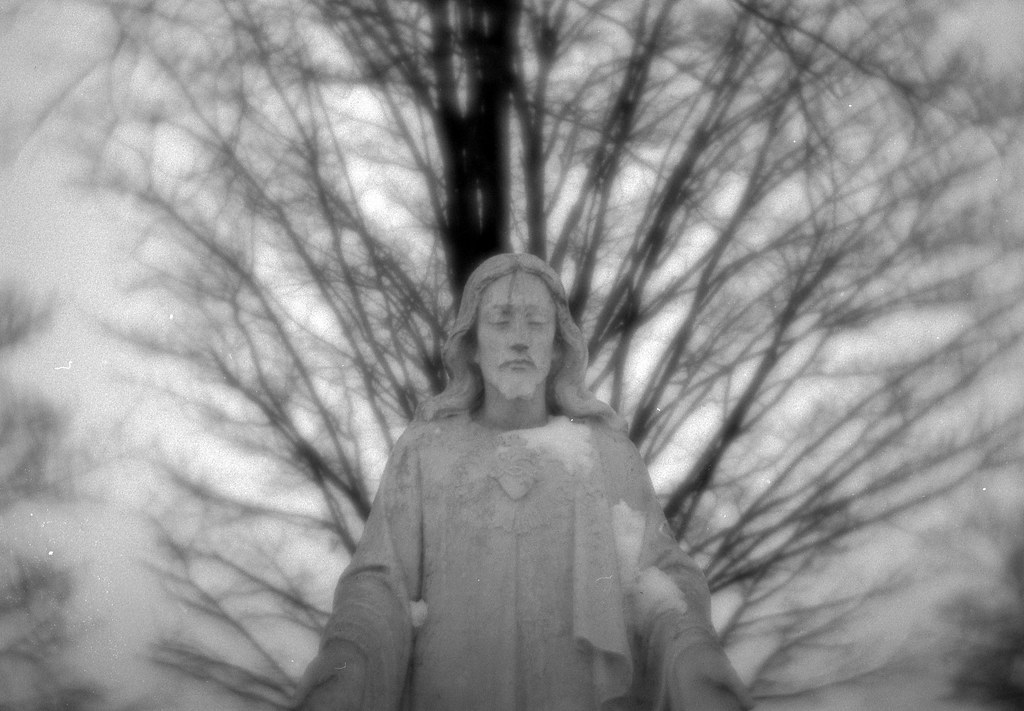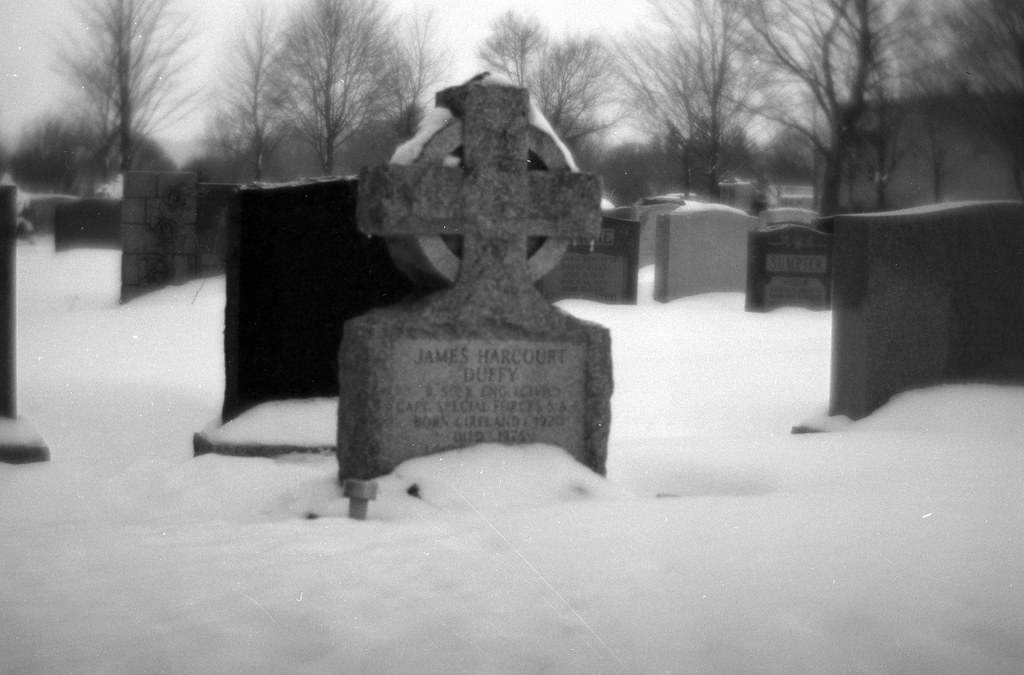This week we’re going a bit cliche when it comes to images. And actually, this week is partly inspired by my good friend James Lee. While I didn’t get to all the places I wanted this week because of a few days worth of snow blocking off driveways, I decided to head into a pair of local cemeteries. And the snow was deep. In some cases, especially on my first stop (Bronte Pioneer), I ended up in knee-deep snow. I know the cliche of photographing cemeteries in black & white. But hey, when it comes to a weekly project, you’re going to hit a lot of cliches. Hopefully, I don’t end up doing a week where I do the study of a line. What makes Milton unique is that many communities have their cemeteries connected with a church, but by the time churches arrived in 1840, they were located in the town proper, and there was no room for a graveyard. Meaning a public graveyard was needed.

Nikon FM – Lomography Daguerreotype Achromat 2.9/64mm – Fomapan 400 @ ASA-200 – FA-1027 (1+14) 8:00 @ 20C
The space occupied by the Bronte Pioneer Cemetery had been considered an unofficial burying ground as early as 1824. With a Mr Thomas Harrison being the first person to make their final resting place. When Milton became a town in the 1850s, the unofficial burying ground became the official cemetery in 1860. This small burying ground became the final resting place of many who had been part of the original town founders. And I noticed many familiar names during my time, such as George Brown (Milton’s first mayor) and the Dempsey Family (which is where the neighbourhood I live now takes its name), along with the original resting place of many in the Martin family. But by the 1870s, the continued rapid growth and the half-acre of the burying ground became worrisome. And with no room to expand due to the completion of two railroad lines, new space had to be found. In November 1880, Mayor D.W. Campbell applied to the town council to establish a new public cemetery and purchase a fire truck. Eventually, a ten-acre parcel of land was purchased from a farmer to develop the new cemetery. Ellen Freeman would be laid to her final rest at Evergreen in 1881. Evergreen followed the same traditions as the earlier cemetery, now available only to those who purchased a plot and remained unconnected to any church or religious denomination. But the trouble with cemeteries is that there is always a need for more space, and the tenets don’t move out once they move in. And despite the rough period through the 1890s, foresight allowed for negotiations towards expansion to start in 1901. The original gates to the cemetery lay at the intersection of Oak and Prince, constructed in 1924 by the local chapter of the IODE (Imperial Order of the Daughters of the Empire). Additional purchases through the 1930s to 1950s brought access to the cemetery along Ontario Street (Highway 25), with a new entrance established in 1964. And while Evergreen continued to grow and expand, the old Bronte graveyard began to decline through neglect and the fact that no one was being interred there, and I’m unsure when the last burial took place. The snow was far too deep to look at all the markers though some did look newish. By 1984 the original cemetery was primarily abandoned and neglected. Thankfully, the Milton Historical Society’s help, along with the only surviving trustee, secured funding for a full restoration. The brush cleared away, graves cleaned and restored. Those markers that were broken embedded in concrete along the one edge (although covered in snow when I visited). Those of the Martin family were moved to Evergreen Cemetery, same for Jasper who’s grave was moved to the Halton Regional Museum, and a marker put in its place. The ground levelled, and a fence erected. And while it remains a place where few visits, it at least allows a connection to Milton’s past. As for Evergreen, today, some 8600 people have their final rest there. Some names I happened across I recognised. Evergreen stands some twenty-six acres and has no more room to expand.

Nikon FM – Lomography Daguerreotype Achromat 2.9/64mm – Fomapan 400 @ ASA-200 – FA-1027 (1+14) 8:00 @ 20C
Nikon FM – Lomography Daguerreotype Achromat 2.9/64mm – Fomapan 400 @ ASA-200 – FA-1027 (1+14) 8:00 @ 20C
The one problem with using such a weird lens, compared to the multi-element optics that make up all my Nikkor glass, is that the number of keepers on a roll drops. Rather than having close to twenty images to choose from, I ended up with about half a roll worth of photos. But if you look at this from the positive angle, I didn’t have a large pool to try and pick just seven to show off. But I knew right off the bat after scanning the images that the feature images must be used for that, taken at Evergreen Cemetery in an area that I’m sure is populated by Roman Catholics is a statue of Jesus with the sacred heart icon on his chest. While far from a perfect image, the tree acts almost as beams of light from his head (another iconic look for an image of Jesus) and the background that tell-tale swirl with the face in sharp focus, but maintaining that dreamy look. In the other photos, I looked for important names in Milton’s history or in my gut, such as Alfred Hemstreet, who was one of Milton’s early photographers. There’s also the Dempsey name, which is the name given to the neighbourhood where I currently live in Milton. Then I just looked for images where I nailed that swirl in the out-of-focus elements.

Nikon FM – Lomography Daguerreotype Achromat 2.9/64mm – Fomapan 400 @ ASA-200 – FA-1027 (1+14) 8:00 @ 20C
Nikon FM – Lomography Daguerreotype Achromat 2.9/64mm – Fomapan 400 @ ASA-200 – FA-1027 (1+14) 8:00 @ 20C
Because I was shooting grave markers and cemeteries, I wanted to get close to the details. I had initially planned on bringing along the iconic Nikkor 105/2.5 lens, but then I noticed a lens that doesn’t see much use, mainly because it’s a weird lens and can be a little hard to use. But as soon as I threw the lens onto the Nikon FM, I knew I had to take it along. That lens is the Lomography Daguerreotype Achromat 1:2.8/64mm. The lens was released a few years back and is a modern take on Charles Chevalier’s lens for the early photographic cameras. It’s soft, dreaming, and produces an iconic swirl in the out-of-focus areas. It was a little bit of visual whiplash from the previous weeks, but it works well in the environment where I was shooting. Lots of background details and elements to render with that swirl. To push this look to the maximum, I shot the lens wide open (f/2.9), and the day was cloudy but bright I ended up over-exposing the film by one stop, shooting at ASA-200. This helped because then I consistently shot at 1/1000″ and still had a bit of over-exposure. To help with this, I also pulled in development using a compensating developer, this case FA-1027, and the results were excellent.

Nikon FM – Lomography Daguerreotype Achromat 2.9/64mm – Fomapan 400 @ ASA-200 – FA-1027 (1+14) 8:00 @ 20C
Nikon FM – Lomography Daguerreotype Achromat 2.9/64mm – Fomapan 400 @ ASA-200 – FA-1027 (1+14) 8:00 @ 20C
Next week I head south to check out Burlington, Ontario and wander along the bay!